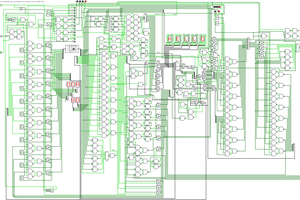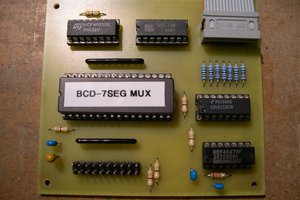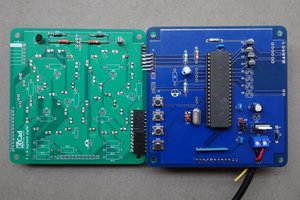4-Bit Full Hex Decoder
A breadboard friendly 4-bit full hex decode board based on GAL16V8 chip.
A breadboard friendly 4-bit full hex decode board based on GAL16V8 chip.
To make the experience fit your profile, pick a username and tell us what interests you.
We found and based on your interests.
gal-7seg-reva.zipEagle CAD Design Files - This work is licensed under a Creative Commons Attribution-NonCommercial 4.0 International License. CC-BY-NC 4.0. Copyright (C) 2018, David Anders. All Rights Reserved.Zip Archive - 41.43 kB - 05/10/2019 at 22:51 |
|
|
16v8.lbrEagle CAD Library for generic 16V8 GAL/PAL part.lbr - 18.78 kB - 04/26/2019 at 19:05 |
|
|
gal-7seg.pldText file with CUPL code for GAL16V8. Use Amtel WinCUPL to compile.pld - 504.00 bytes - 01/11/2019 at 02:57 |
|
|
gal-7seg.pdfPDF Schematic For GAL16V8 4-Bit Full Hex Decoder - This work is licensed under a Creative Commons Attribution-NonCommercial 4.0 International License. CC-BY-NC 4.0, Copyright (C) 2018, David Anders. All Rights Reserved.Adobe Portable Document Format - 14.42 kB - 01/11/2019 at 02:54 |
|
|
Create an account to leave a comment. Already have an account? Log In.
Here's an 8-bit version using a 16V8: https://github.com/linker3000/GALBinaryTo7Seg
Fantastic! I am glad you were inspired by this project to do something yourself! what license have you placed on the design?
Oh, that was something I did a couple of years back. No licence stated - good point, I'll get around to dropping in a GPL one next time I update the files or if someone asks.
add dandy! i've created a new project - https://hackaday.io/project/164540-8-bit-hex-decoder
I run WinCUPL on Win7 and have several Runtime errors 372 (despite the fact I run it in WinXP compatibility mode) onb TABCTL32.OCX
Anyway, I can compile the file without errors.
I also have MiniPro and a TL866 to flash the GAL, but which file has to be flashed ? I don't see an .HEX file...
thanks for any help
Yes, there is one
Is it that simple ?
Since I cannot change (even consult) the options of the compiler because of the TABCTL32.OCX error, I use the default options.
I will try to flash that file in the GAL.
Thanks, Ken !
You know that often documentation for old programs are online? http://ww1.microchip.com/downloads/en/DeviceDoc/doc0737.pdf
Yes indeed. I overlooked that, sorry...
Thanks for the link
An OCX file apparently contains forms for an application. Perhaps your installation is damaged. Maybe consider reinstalling WinCUPL, since it's a free program anyway.
cool project! I made a similar GAL about 20 years ago to imitate the obsolete DM9368. http://pdf.datasheetcatalog.com/datasheet/fairchild/DM9368.pdf
I guess that ATF16V8B can be used as well? Still in production and only costs $0.62 in 5K qty...
The part I am using is actually the ATF16V8B. In the description I referenced it as a generic GAL part...
A Generic GAL you say? So that would be a "Generic Generic Array Logic" device then. That must be those newfangled G2AL that is all the rage nowadays ;-)
Joking aside, It's a nice project, too bad that there aren't enough outputs on the GAL to implement a ripple-blanking output on it as well for full awesomeness.
Cool project! What do you use to program the GALs? I haven't burned one in years - my ancient programmer needed Windows
@matseng don't diss leading zeros, man, unless you enjoy watching movies about agents code-named "7" :-)
Also, there used to be 22V10s with more outputs, not sure if any compatibles are still in production.
@Ted Yapo - i'm using the TL866 series programmers. i've not been able to get them to program using the open source linux based tools, however the windows based software seems to work without an issue...
This looks interesting. I'd like to learn more about PLDs - would something like this be a good way to get started?
The GAL16V8 parts are pretty limited, but good for replacing blocks of combined logic. The programming "language" for these is known as CUPL, which is a lot more cryptic and not as commonly used as VHDL or Verilog. I'd recommend looking into something with the Altera MAX700 series ( https://www.digikey.com/product-detail/en/intel/EPM7064SLC44-10N/544-2012-ND/1084676). I made a little dev board for that part a while back - https://hackaday.io/project/28167-digital-design-doohickey/log/70446-i-have-your-io
Become a member to follow this project and never miss any updates

 SHAOS
SHAOS
 Mike Szczys
Mike Szczys
 Daniel
Daniel
 Ken Yap
Ken Yap
It would be cute if you fit these the pcb in a small pill bottle and brought out the leads in a micro octal tube socket pattern. Neo nixie displays..